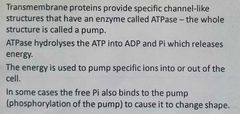![]()
![]()
![]()
Use LEFT and RIGHT arrow keys to navigate between flashcards;
Use UP and DOWN arrow keys to flip the card;
H to show hint;
A reads text to speech;
10 Cards in this Set
- Front
- Back
|
4 Functions of Membrane Proteins |
TRANSPORT - regulation of transport of substances into and out of the cell through selective and differential permeability
SIGNALLING - Detection of chemical messages arriving at the surface of the cell via ligands binding to receptors
INTERCELLULAR INTERACTIONS BETWEEN ADJACENT CELLS- Linking of adjacent cells by membrane junctions
IONIC & HYDROSTATIC BALANCE- Generation and maintenance of the resting membrane potential |
|
|
Define Passive Transport Across the Cell Membrane |
Doesn't require ATP Mediated by Gradients Movement will continue until there is equalization and the gradient no longer exists
|
|
|
Name three types of gradient that exist |
Electrical Gradient opposite charges attract
Chemical or Concentration Gradient Movement from high concentration to low
Osmotic Gradient Water moves to an area of high osmolarity
|
|
|
What properties must a substance have to pass through the cell membrane |
Must be Small Lipid soluble |
|
|
Examples of molecules that pass through the cell membrane by simple diffusion. |
Oxygen
Carbon dioxide
Steroids
Alcohol |
|
|
Examples of molecules that pass through the cell membrane facilitated by channels |
Ions Water (channels called aquaporins) |
|
|
Examples of molecules that pass through the cell membrane facilitated by transporters or carrier proteins |
Larger solutes
Glucose (GLUt transporters)
Amino Acids |
|
|
Describe properties of ion channels |
Transport ions (Na+, K+, Cl-, Ca++). Movement still driven by gradients Can be selective and differential Can be opened and closed by: Chemicals (ligands) binding to receptors - chemically or ligand gated channels Changes in electrical charge detected by voltage sensors on the channel - voltage gated channels |
|
|
Define Active Transport |
Pumps use energy to move substances against a chemical geadient. |
|
|
Define ATPase |

|

